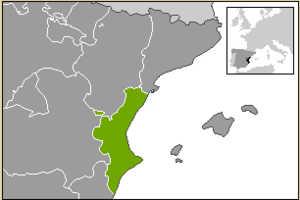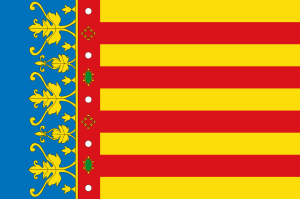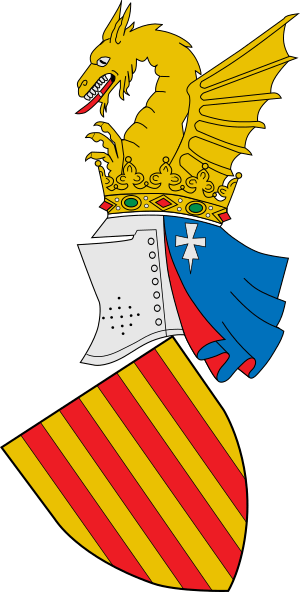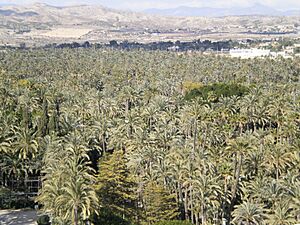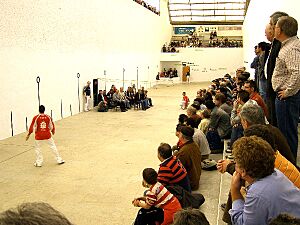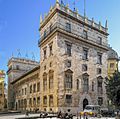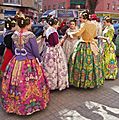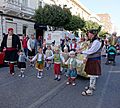Valencia (autonomous community) facts for kids
Valencia, also known officially as the Valencian Community (or sometimes the Valencian Country), is a special region in Spain. It's located on the eastern coast of the country, right by the Mediterranean Sea. About 5 million people live here. The biggest city and capital is Valencia, which has nearly 800,000 residents. Valencia city is also the capital of the Valencia province.
The second-largest city in the Valencian Community is Alicante, with about 332,000 people. It's the capital of the Alicante province. Another important city in Alicante province is Elche, home to 230,000 people and a big center for industries. Castellón, with 180,000 residents, is the capital of the Castellón province.
Contents
What is the Valencian Community?
The Valencian Community is one of Spain's 17 "autonomous communities." This means it has its own government and laws, but it's still part of Spain. It's a bit like a state in the USA or a province in Canada. The region has a rich history, once known as the Kingdom of Valencia.
Major Cities and Their Importance
The Valencian Community is home to several important cities, each with its own special features.
Valencia City: The Capital
The city of Valencia is the heart of the region. It's a vibrant place where old history meets modern architecture. One of its most famous landmarks is the Ciutat de les Arts i les Ciències (City of Arts and Sciences), a futuristic complex with museums, an opera house, and an oceanographic park. Valencia is also famous for its delicious paella, a traditional Spanish rice dish.
Alicante: A Coastal Gem
Alicante is a popular coastal city known for its beautiful beaches and warm weather. It's a major tourist destination, especially for people looking for sun and sea. The city also has a busy port and an international airport, making it an important gateway to the region. The Alicante light tram helps people get around the city easily.
Elche: The Palm City
Elche is unique because it has a huge palm grove, the Elche palm grove, which is a UNESCO World Heritage site. It's one of the largest palm groves in Europe! Besides its natural beauty, Elche is a strong industrial city, especially known for its shoe manufacturing.
Castellón: Northern Gateway
Castellón de la Plana is the capital of the northernmost province of the Valencian Community. It's a city with a mix of industrial activity and cultural heritage. It serves as an important hub for the northern part of the region.
Culture and Traditions
The Valencian Community has a unique culture, influenced by its history and location.
Valencian Language
While Spanish is spoken everywhere, the region also has its own language called Valencian. It's very similar to Catalan and is spoken by many people, especially in the central and northern parts of the region. Both Spanish and Valencian are official languages.
Festivals and Celebrations
The Valencian Community is famous for its lively festivals.
- Las Fallas: This is one of the most spectacular festivals, held in Valencia city in March. Huge artistic figures (fallas) are built and then burned in a grand display of fireworks.
- Muixeranga: In towns like Algemesí, you can see Muixeranga human towers, where people stand on each other's shoulders to form tall, impressive structures. This is part of the Festival of Our Lady of Health.
Traditional Sports
A traditional sport unique to the region is Valencian pilota. It's a handball game played in special courts called trinquets. It's a fast-paced and exciting sport that's deeply rooted in Valencian culture.
Images for kids
-
Employees demonstrate in front of the RTVV headquarters in Burjassot the day of its closure.
-
Valencian coat of arms over the entrance of Serranos Towers
-
Rock of Ifac in Calp
-
Altamira Palace, Elche
-
Muixeranga human tower at La Mare de Déu de la Salut Festival' of Algemesí
-
Valencian espardenya
See also
 In Spanish: Comunidad Valenciana para niños
In Spanish: Comunidad Valenciana para niños


